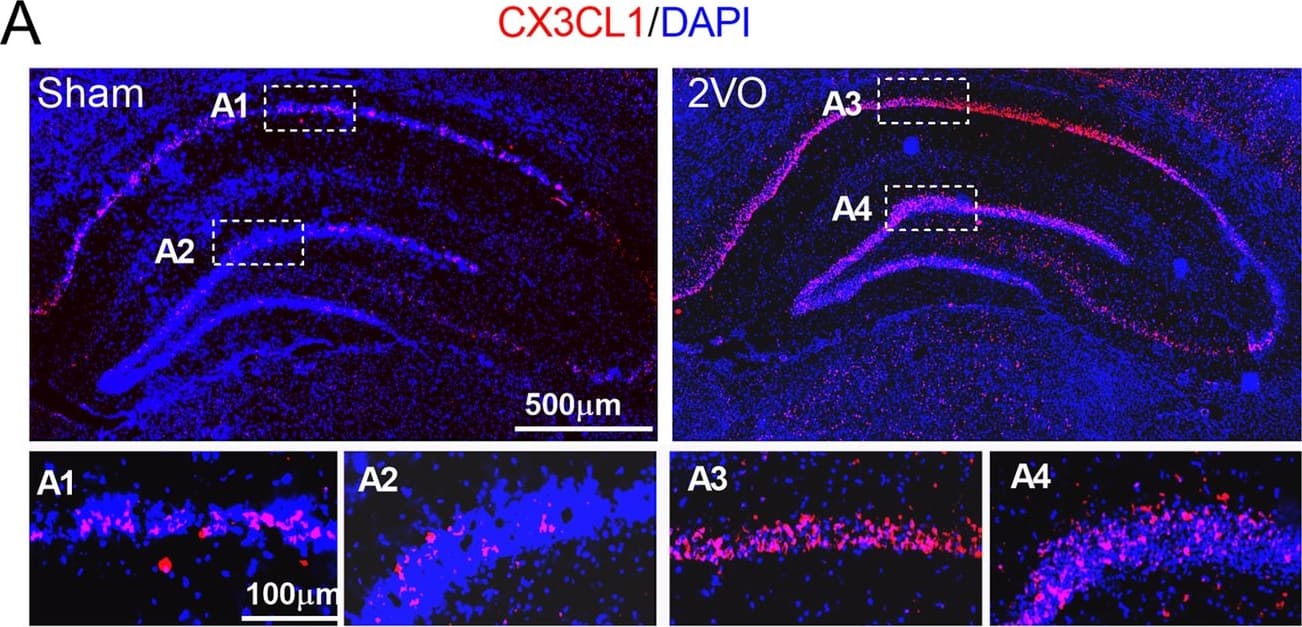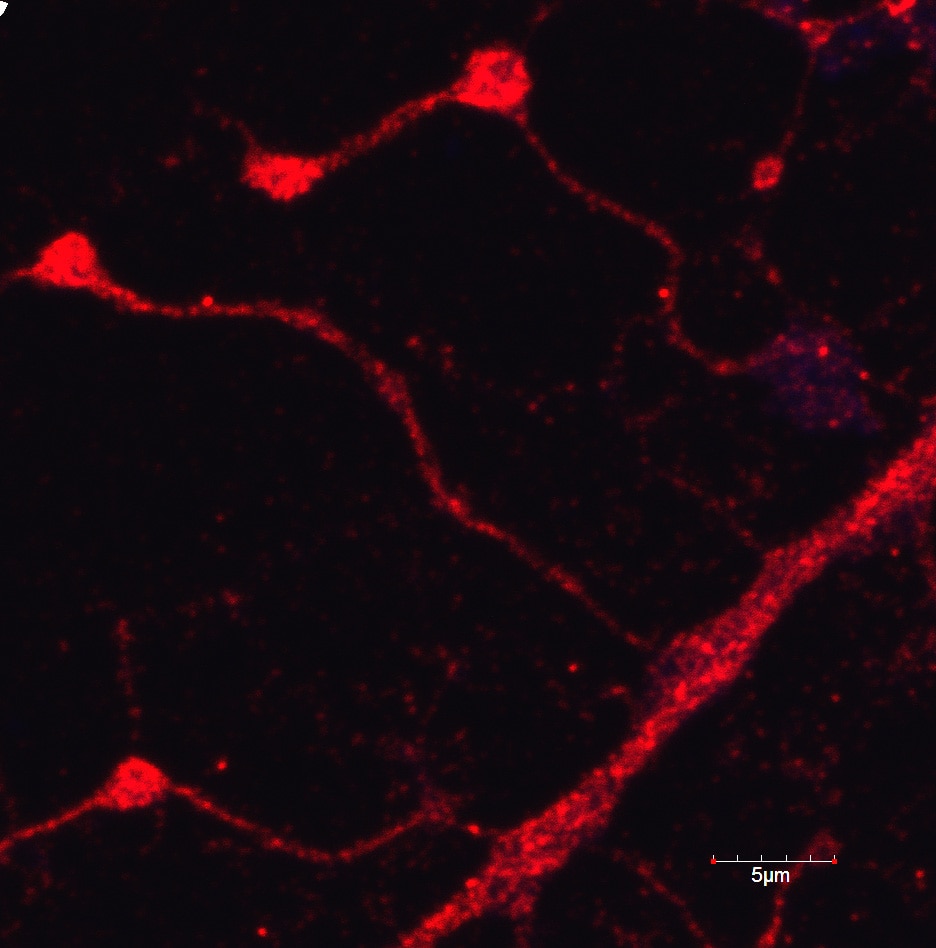Rat CX3CL1/Fractalkine Chemokine Domain Antibody Summary
Gln25-Gly100
Accession # O55145
Applications
Rat CX3CL1/Fractalkine Sandwich Immunoassay
Please Note: Optimal dilutions should be determined by each laboratory for each application. General Protocols are available in the Technical Information section on our website.
Scientific Data
 View Larger
View Larger
Chemotaxis Induced by CX3CL1/Fractalkine and Neutralization by Rat CX3CL1/Fractalkine Antibody. Recombinant Rat CX3CL1/Fractalkine (Catalog # 536-FR) chemoattracts the BaF3 mouse pro-B cell line transfected with human CX3CR1 in a dose-dependent manner (orange line). The amount of cells that migrated through to the lower chemotaxis chamber was measured by Resazurin (Catalog # AR002). Chemotaxis elicited by Recombinant Rat CX3CL1/Fractalkine (40 ng/mL) is neutralized (green line) by increasing concentrations of Goat Anti-Rat CX3CL1/Fractalkine Chemokine Domain Antigen Affinity-purified Polyclonal Antibody (Catalog # AF537). The ND50 is typically 0.3-1.2 µg/mL.
 View Larger
View Larger
CX3CL1/Fractalkine in Mouse Brain. CX3CL1/Fractalkine was detected in perfusion fixed frozen sections of mouse brain (cingulate cortex) using 1.7 µg/mL Goat Anti-Rat CX3CL1/Fractalkine Chemokine Domain Antigen Affinity-purified Polyclonal Antibody (Catalog # AF537) overnight at 4 °C. Tissue was stained with the Anti-Goat HRP-DAB Cell & Tissue Staining Kit (brown; Catalog # CTS008) and counterstained with hematoxylin (blue). View our protocol for Chromogenic IHC Staining of Frozen Tissue Sections.
 View Larger
View Larger
Detection of Rat CX3CL1/Fractalkine by Immunohistochemistry Upregulation of the expression of CX3CL1 and CX3CR1 in the hippocampus of 2VO and miR-195 loss-of-function rats. a, b Expression of CX3CL1 (red) and CX3CR1 (green) in the hippocampus of sham and 2VO rats was shown by immunofluorescence staining. The scale bar is 500 um. c Expression of CX3CL1 and CX3CR1 in the hippocampus of sham and 2VO rats detected by western blot technique. Bars represent the mean ± SD, n = 6, *P < 0.05 vs sham group, Student’s t test. d Lenti-pre-AMO-miR-195 upregulated the expression of CX3CL1 in rat hippocampus. Mean ± SD, n = 6, *P < 0.05 vs sham; #P < 0.05 vs lenti-pre-AMO-miR-195. Data were analyzed using one-way ANOVA followed by Tukey test. e Lenti-pre-AMO-miR-195 upregulated the expression of CX3CR1 in the rat hippocampus. Mean ± SD, n = 6, *P < 0.05 vs sham; #P < 0.05 vs lenti-pre-AMO-miR-195. Data were analyzed using one-way ANOVA followed by Tukey test Image collected and cropped by CiteAb from the following open publication (https://pubmed.ncbi.nlm.nih.gov/32819407), licensed under a CC-BY license. Not internally tested by R&D Systems.
Preparation and Storage
- 12 months from date of receipt, -20 to -70 °C as supplied.
- 1 month, 2 to 8 °C under sterile conditions after reconstitution.
- 6 months, -20 to -70 °C under sterile conditions after reconstitution.
Background: CX3CL1/Fractalkine
CX3CL1, also named neurotactin, is a member of the delta chemokine subfamily that contains a novel C-X3-C motif. Unlike other known chemokines, CX3CL1 is a type 1 membrane protein containing a chemokine domain tethered on a long mucin-like stalk. Rat CX3CL1 cDNA encodes a 393 amino acid (aa) residue precursor protein with two alternative (21 aa or 24 aa residue) putative signal peptides, a 74 aa or 76 aa residue globular chemokine domain, a 238 aa residue stalk region rich in Gly, Pro, Ser and Thr and containing degenerate mucin-like repeats, a 19 aa residue transmembrane segment and a 36 aa residue cytoplasmic domain. The extracellular domain of CX3CL1 can potentially be released as a soluble protein by proteolysis at the conserved dibasic motif proximal to the transmembrane region. With the exception of the stalk region, rat CX3CL1 shares a high degree of amino acid sequence homology (83% sequence identity) with human and mouse CX3CL1. CX3CL1 is expressed in various tissues including heart, brain, lung, kidney, skeletal muscle, and testis. In rat brain, CX3CL1 expression was found to be localized principally to neurons. The expression of CX3CL1 was also reported to be up-regulated on activated endothelial cells. Membrane-bound CX3CL1 has been shown to promote adhesion of leukocytes. The soluble chemokine domain of human CX3CL1 was reported to be chemotactic for T cells and monocytes while the soluble chemokine domain of mouse CX3CL1 was reported to chemoattract neutrophils and T‑lymphocytes but not monocytes. CX3CR1, previously named V28 or chemokine beta receptor‑like 1, has been found to be a specific receptor for CX3CL1. In addition, US28, a 7TM receptor encoded by human cytomegalovirus that binds multiple CC chemokines, has also been shown to bind CX3CL1 with high-affinity.
- Kledal, T.N. et al. (1998) FEBS Lett. 441:209.
- Combadiere, C. et al. (1998) J. Biol. Chem. 273:23799.
- Harrison, J.L. et al. (1998) Proc. Natl. Acad. Sci. USA 95:10896.
- Rossi, D.L. et al. (1998) Genomics 47:163.
Product Datasheets
Citations for Rat CX3CL1/Fractalkine Chemokine Domain Antibody
R&D Systems personnel manually curate a database that contains references using R&D Systems products. The data collected includes not only links to publications in PubMed, but also provides information about sample types, species, and experimental conditions.
17
Citations: Showing 1 - 10
Filter your results:
Filter by:
-
Microglial phagocytosis and activation underlying photoreceptor degeneration is regulated by CX3CL1‐CX3CR1 signaling in a mouse model of retinitis pigmentosa
Authors: Matthew K. Zabel, Lian Zhao, Yikui Zhang, Shaimar R. Gonzalez, Wenxin Ma, Xu Wang et al.
Glia
-
Cerebrospinal fluid-contacting nucleus mediates nociception via release of fractalkine
Authors: Q.Q. Zhou, S.S. Chen, Q.Q. Zhang, P.F. Liu, H.Z. Fang, Y. Yang et al.
Brazilian Journal of Medical and Biological Research
-
CX3CL1 is up-regulated in the rat hippocampus during memory-associated synaptic plasticity
Authors: Graham K. Sheridan, Anita Wdowicz, Mark Pickering, Orla Watters, Paul Halley, Niamh C. O’Sullivan et al.
Frontiers in Cellular Neuroscience
-
CX3CL1 Promotes Breast Cancer via Transactivation of the EGF Pathway
Authors: Manuel Tardáguila, Emilia Mira, Miguel A. García-Cabezas, Anna M. Feijoo, Miguel Quintela-Fandino, Iñigo Azcoitia et al.
Cancer Research
-
Spinal Cathepsin S promotes visceral hypersensitivity via FKN/CX3CR1/p38 MAPK signaling pathways
Authors: Sun, P;Lin, W;Weng, Y;Gong, J;Huang, Y;Tang, Y;Lin, C;Chen, A;Chen, Y;
Molecular pain
Species: Rat
Sample Types:
Applications: In Vivo -
Temporal alteration of microglia to microinfarcts in rat brain induced by the vascular occlusion with fluorescent microspheres
Authors: Y Shen, J Cui, S Zhang, Y Wang, J Wang, Y Su, D Xu, Y Liu, Y Guo, W Bai
Frontiers in Cellular Neuroscience, 2022-08-03;16(0):956342.
Species: Rat
Sample Types: Whole Tissue
Applications: IHC -
MicroRNA-195 prevents hippocampal microglial/macrophage polarization towards the M1 phenotype induced by chronic brain hypoperfusion through regulating CX3CL1/CX3CR1 signaling
Authors: M Mao, Y Xu, XY Zhang, L Yang, XB An, Y Qu, YN Chai, YR Wang, TT Li, J Ai
J Neuroinflammation, 2020-08-20;17(1):244.
Species: Rat
Sample Types: Whole Cells, Whole Tissue
Applications: ICC, IHC -
Cx3cr1-deficiency exacerbates alpha-synuclein-A53T induced neuroinflammation and neurodegeneration in a mouse model of Parkinson's disease
Authors: S Castro-Sán, ÁJ García-Yag, T López-Royo, M Casarejos, JL Lanciego, I Lastres-Be
Glia, 2018-04-06;0(0):.
Species: Mouse
Sample Types: Whole Tissue
Applications: IHC -
Noradrenaline induces CX3CL1 production and release by neurons
Authors: José L M Madrigal
Neuropharmacology, 2016-12-05;114(0):146-155.
Species: Rat
Sample Types: Cell Lysates, Whole Cells
Applications: ICC, Western Blot -
Astaxanthin Inhibits Expression of Retinal Oxidative Stress and Inflammatory Mediators in Streptozotocin-Induced Diabetic Rats.
Authors: Yeh P, Huang H, Yang C, Yang W, Yang C
PLoS ONE, 2016-01-14;11(1):e0146438.
Species: Rat
Sample Types: Cell Lysates, Whole Tissue
Applications: IHC-P, Western Blot -
Selective activation of microglia facilitates synaptic strength.
Authors: Clark A, Gruber-Schoffnegger D, Drdla-Schutting R, Gerhold K, Malcangio M, Sandkuhler J
J Neurosci, 2015-03-18;35(11):4552-70.
Species: Rat
Sample Types: Whole Cells
Applications: Neutralization -
Interactions between chemokines: regulation of fractalkine/CX3CL1 homeostasis by SDF/CXCL12 in cortical neurons.
Authors: Cook A, Hippensteel R, Shimizu S, Nicolai J, Fatatis A, Meucci O
J. Biol. Chem., 2010-02-02;285(14):10563-71.
Species: Rat
Sample Types: Cell Lysates
Applications: Western Blot -
Inhibition of spinal microglial cathepsin S for the reversal of neuropathic pain.
Authors: Clark AK, Yip PK, Grist J, Gentry C, Staniland AA, Marchand F, Dehvari M, Wotherspoon G, Winter J, Ullah J, Bevan S, Malcangio M
Proc. Natl. Acad. Sci. U.S.A., 2007-06-05;104(25):10655-60.
Species: Rat
Sample Types: In Vivo, Whole Cells
Applications: ICC, Neutralization -
CX3CR1-dependent renal macrophage survival promotes Candida control and host survival
Authors: Michail S. Lionakis, Muthulekha Swamydas, Brett G. Fischer, Theo S. Plantinga, Melissa D. Johnson, Martin Jaeger et al.
Journal of Clinical Investigation
-
Sustained expression of MCP-1 by low wall shear stress loading concomitant with turbulent flow on endothelial cells of intracranial aneurysm
Authors: Tomohiro Aoki, Kimiko Yamamoto, Miyuki Fukuda, Yuji Shimogonya, Shunichi Fukuda, Shuh Narumiya
Acta Neuropathologica Communications
-
Fractalkine Signaling Regulates Macrophage Recruitment into the Cochlea and Promotes the Survival of Spiral Ganglion Neurons after Selective Hair Cell Lesion
Authors: Tejbeer Kaur, Darius Zamani, Ling Tong, Edwin W. Rubel, Kevin K. Ohlemiller, Keiko Hirose et al.
The Journal of Neuroscience
-
Fractalkine and CX 3 CR1 regulate hippocampal neurogenesis in adult and aged rats
Authors: Adam D. Bachstetter, Josh M. Morganti, Jennifer Jernberg, Andrea Schlunk, Staten H. Mitchell, Kaelin W. Brewster et al.
Neurobiology of Aging
FAQs
No product specific FAQs exist for this product, however you may
View all Antibody FAQsReviews for Rat CX3CL1/Fractalkine Chemokine Domain Antibody
Average Rating: 4 (Based on 2 Reviews)
Have you used Rat CX3CL1/Fractalkine Chemokine Domain Antibody?
Submit a review and receive an Amazon gift card.
$25/€18/£15/$25CAN/¥75 Yuan/¥2500 Yen for a review with an image
$10/€7/£6/$10 CAD/¥70 Yuan/¥1110 Yen for a review without an image
Filter by:




